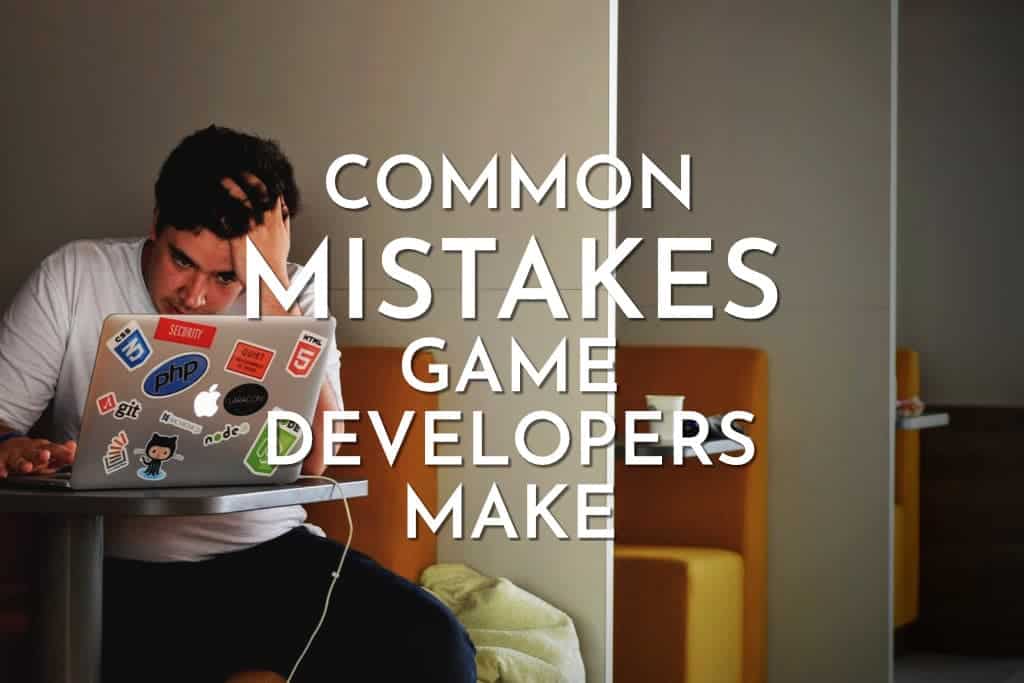Avoiding rookie mistakes is one way to make sure that your game has a higher chance of succeeding. Today, I have set out to discover the 21 most common mistakes made by game developers.
This will provide you with helpful tips on how to create a financially profitable game, and accelerate its growth while also increasing marketability.
I will show you how to figure out the correct way to design your game, using tips & tricks sourced from veteran developers and industry leaders. Whether you’re a PC, mobile, or console game dev, we have something for everyone. So let’s get started.
Trying To Create Something Perfect

Thomas Edison once said “I have not failed. I’ve just found 10,000 ways that won’t work”. Failure is not something to be ashamed of, rather an experience to be learned from during the path to success. The greatest games of today were born as weird ideas, that nobody in their right mind would’ve taken seriously before seeing the finished product.
Halo at its core is a game about genetically modified super soldiers fighting invasive space aliens. Mario is an Italian plumber who eats shrooms and jumps around while collecting coins. The developers for these games didn’t create a coherent, perfect product right from the start.
They had a concept, tested it out, bounced ideas between team members, and crawled towards success one step at a time. Failing many times along the way.
A lot of the developers spend too much time debating if an idea is perfect, and only once they’ve found the perfect idea will they start working on it. But you spend so much time coming up with your version of a “perfect concept” which in the end is just as flawed as any of the other ideas. We are human after all, and making mistakes is part of our nature.
The best games aren’t perfect, they have flaws. Sometimes flaws create a character and make the game even more enjoyable. Nobody wants a perfect character or weapon; they want to see weaknesses. Weaknesses and challenges are what make the journey exciting, like in every anime ever where the main character is really flawed at the start and becomes super strong by the end.
Okay, maybe that’s not the best analogy, but you get the point. Don’t be afraid to fail, and always keep iterating upon your ideas. The whole process is about getting closer to perfection with each consecutive step, you don’t start with perfection.
A Good Game Doesn’t Make A Marketable Game

Your game has great graphics and sound design, with interesting gameplay and brilliantly crafted levels. Is it a good game? Of course. But is it going to be profitable?
That’s debatable because we still don’t know if there is a demand in the market for the game you’ve created. This might sound confusing, why wouldn’t players download a well-polished game with tons of features? Well, there can be various reasons.
But the one we are focusing on is demand since the market might already be saturated with games of a similar genre that released way before yours. Often developers put a whole lot of time into measuring statistics such as ARPU and retention, instead of judging how marketable their game is.
Delaying The Marketing

When you think about marketing in the video game industry, what is the first thing that comes to your mind? From the perspective of a gamer who only plays the latest AAA titles on their console, it may seem very much like Hollywood’s big-budget promotion.
High-quality animations, live-action ads on the TV, joint ventures with large brand names, celebrities promoting the game, etc. Basically, tens of millions being spent on marketing. But marketing is a completely different story for indie studios. Often times, they use their community to get free publicity.
Your first game on the Play Store can be promoted very cheaply if you know how and WHEN to do it. The “when” is extremely important, and as a general rule of thumb it is done right from the start. Haven’t considered marketing from Day 1 of the project? You’re missing out on potential customers and losing time.
If you simply set up a home page, blog, or subreddit for your game you’ve already gathered a bunch of followers. Add in an official Twitter account with daily updates, and you increase your reach even further. A lot of devs often worry that if they share the game concept/ features very early, others will steal their ideas. Well if you don’t, nobody will even realize that your game launched two days ago.
Not Knowing What To Focus On

Games are developed by creative people with a passion for the art form. And it is often this passion that drives developers to try and cram in as many innovative features as possible.
During the design phase, you’ll end up with plenty of crazy ideas and concepts that on paper sound great. Some of these ideas are genuinely good for the gameplay experience and should be implemented.
But a lot of the other stuff is just filler or simply impractical. Because you find something personally appealing, you might try to implement it within the game. This will further be helped by the fact that you’ve been playing your own game since day 1 of development.
But you also need to think about it from the player’s perspective, one who picks up the game for the first time. Instead of needlessly cluttering the development process and wasting valuable resources, focus on the core of your game.
What truly makes it enjoyable. Talk to others in the development team, maybe show a prototype of the ideas to potential players via social media. And consider their feedback, because your personal judgment might be clouded by your love for your creation.
Failing to Iterate Your Ad Monetization Strategy

As a developer, you never want to make changes that affect monetization based on instinct alone. Especially when it comes to ad monetization strategies. Try to answer certain questions like “is it a good idea to use banner ads in X country?” or “should we play interstitials after the first level?”.
Try to A/B test various ad monetization models, to get a better idea of which ads appeal to players of a certain demographic and country. Is that coin drop after beating a boss in level 3 required? How do players react to it?
Which ad type are players engaging with the most? Let’s say your game plays a rewarded video ad after the player fails a level. But you discover that player retention is dropping at this exact point, and a particular group of users never return to play the game after failing that level.
This is where A/B testing comes in, you can test groups of users by placing different types of ads at various points in the game to see which strategy maximizes retention. Make data-based decisions, and constantly strive to optimize and update the monetization strategy.
Putting More Time Into UI Rather Than Gameplay

The interface is an important part of any game. But that doesn’t mean you should spend 2 months fine-tuning the HUD when the gameplay hasn’t been polished yet. Yeah, it is annoying to have your ammo count displayed in an awkward spot, or the reload indicator not showing up when your gun goes empty.
But you know what is truly infuriating? Bad gameplay, imbalanced maps, and overpowered weapons. You see, people don’t think about the UI while purchasing or downloading a game.
They look at the gameplay, storyline, etc. Great gameplay will always triumph over great UI design. You can do both at the same time, but if you had to focus on just one thing, it would be gameplay.
Assuming What The Player Needs

This is another very common mistake made by devs with little experience. A lot of them use instinct instead of looking at data while determining which features the players want within a game.
Say you are the developer of an FPS series like Call of Duty. Maybe you want to take it up to the next level by implementing something that is possibly controversial in the next installment of the series.
You think it is revolutionary, but the players of your game who are accustomed to the older mechanics won’t take too kindly to such a change.
Any changes that fundamentally change the playstyle or flow of your game will have lasting repercussions, good or bad. For a long time after the launch. Survey the target groups, read online forums, and think about what the player wants.
Make Games, Not Game Engines

There is this tendency among certain game devs who want to be revolutionaries of some sort by coding their own game engine from scratch instead of just using the hundreds of prebuilt tools that are out there for everyone to access.
You don’t have to understand how game engines work as long your end product makes money. Game engines are the single most complicated piece of software involved in game creation. Modern game engines have modules for physics, AI, graphics rendering, debugging, exporting, and much more.
Creating one from scratch will take years. Moral of the story- if you want to make games, don’t get into game engine development.
Lacking A Post-Launch Monetization Strategy

A lot of the time, you’ll read articles about how developers plan their monetization strategies right from the start. But things change as the game progresses, and features that you initially planned won’t make it to the final version. As a result, you will also have to switch up the monetization.
Different coin drop rates for game balance changes to loot boxes, redesigning the cosmetics to adjust for different demographics, etc. Once you have a playable version of the final product, you need to start considering how you’ll monetize your game after it hits the store.
Unless you want your app to vanish into the sea that is thousands of other apps, you need to market it properly. Try to get featured on popular game journalism sites, send out review copies to gaming channels on Youtube, and keep your community updated on the latest developments via social media.
If it is a mobile game, you can try cross-advertising through other popular apps by contacting different developers.
Blatantly Copying Ideas From Others

Here’s the deal with the gaming industry- one guy comes up with a brilliant idea that is both innovative and marketable, his game turns into a smash hit. Within months, the market is flooded with rip-offs and clones that use generic assets purchased from online stores.
No quality control, creativity, or elaborate plan. Just lazy devs trying to make a quick buck off other people’s work. This should not be mistaken with two games sharing the same genre and having similar features, like Fortnite vs PUBG.
Both are Battle Royales, but Fortnite has a completely different art style, map, gameplay, and it has the building mechanic which is totally new. Did Fortnite try to capture the same market as PUBG by releasing after the latter proved extremely successful?
Yes, but Fortnite did it better and in its own way. It is good to take inspiration from others and creating something unique from those ideas. But imitation is not acceptable.
Sharing Too Much

A problem that is particularly noticeable in the world of indie game devs. One of the cornerstones of developing an indie game is sharing the whole development experience with the rest of the world, by creating a community of fans and colleagues.
The immediate feedback you get through social media and forums is extremely valuable. One can even say it makes the whole idea of being an indie dev possible since you aren’t alone. But there are some things you should not put out there since it can negatively affect development.
For some people the feeling they get when others appreciate their hard work is a motivator. But it can often act as a double-edged sword. For example, a developer posts a gameplay clip on his personal blog or twitter page asking for critical feedback regarding some of the new features he added to his game. Then he says, “ignore that weird glitch” or “we will fix it with better textures later”.
Clearly, you are aware that these parts of the game aren’t ready yet, so asking for feedback is sort of redundant and only soils the image of your company/ studio. The solution? Waiting. People will respond much better to a finished product, even if it is in alpha.
Messing Up Game Localization

Releasing your game globally? Well, in that case, you will have to take care of localization. Translating the audio and text is only one part of the equation, you also have to customize things like drop rates and ad placement.
You might need to cut out certain portions of the game as per local cultures and regulations or add things to the game that will make it more popular in a certain nation.
Anyways, a lot of game devs mess either mess up localization or don’t pay enough attention to it which can hurt revenue. To ensure that you are getting the most out of your game, you will have to avoid some things. Like preferring cost over quality. They say you get what you pay for, and hiring a good localization company has its merits.
Another thing you want to avoid is time crunches while localizing your game. There is a release date for the worldwide launch, but sometimes it is better to delay the affair by a few days instead of rushing a broken product. Be wary of localization services that claim to meet tight deadlines.
Another mistake made by devs and studios is not maintaining a close relationship with the linguist, which ends up resulting in misrepresented text or even missing information. And then there’s the cardinal sin- forgetting to test your final product.
Making The Main Character Too Big

New game developers are the usual suspects when it comes to making the main character too large. This happens when someone has devoted a lot of time and energy towards making the perfect superhero or monster, and they want to show it off by making it take the centerstage within the game.
Or maybe they just want the players to see it more easily, including all the detail they put into its model. While these ideas sound good on paper, they are actually very impractical. Well designed games are all about balance, from the visuals to the sound.
No one element should overpower the rest, and large characters affect the way a player views the game world. It also distracts the player from viewing the background or a nearby obstacle. If the character jumps, flies, or rolls then it makes no sense to have a large model covering up the middle of the screen.
And it also makes sense from a design perspective- you need less time to create a smaller model. A good idea is to check your character size by superimposing it on a similar game from a well-established studio.
Forgetting About The Community

This point is targeted primarily at games released in early access state (like PUBG when it first arrived on Steam in March 2017). A lot of devs make the mistake of thinking that early access is simply a means to test features and receive free feedback.
While feedback is one of the main reasons we use early access, it isn’t the only one. Think of it is a collaborative effort by the entire community and not just the studio, focused on improving the game.
As such, the developer should have an active presence in social media and gaming forums. Constantly communicating with the fans, maybe a few behind the scenes videos. Remember to treat the community as if they are a part of the team.
Importing A Bunch Of Alien Code To Fix Problems

Ask industry professionals about this, and they will you how many times it has happened. Especially with young game programmers, who try to hotfix problems by copy-pasting foreign code into an existing project.
Or by buying a bunch of assets from the Unity Store. The end result is a game that has several hidden “black boxes” which the rest of the team doesn’t understand.
More often than not, these foreign modules of code include their own quirks/ bugs. It is especially hard to deal with because they usually aren’t even formatted correctly.
Chasing The Leaders

Every industry has its “king” or that one company which rose to the number 1 spot through a combination of creativity, innovation, aggressive marketing, rapid expansion, etc. And this company acts as a benchmark for others who strive to take its place.
Ford in cars, Beatles in music, Spielberg in movies, and so on. Things are a little trickier with the gaming scene where empires rise and fall in a matter of months, it is hard to say who the “king” is. There are plenty of large publishers, yes.
Activision, Ubisoft, EA and so on. For our example, we shall consider the game which is #1 in terms of popularity or revenue. We’ve discussed before, the issue with copycats who blatantly copy other people’s ideas. But this is different, here devs genuinely create their own vision but end up following the industry trend instead of innovating.
You can see it with the oversaturation of Battle Royale games, it became the new flavor of the month back in 2017 and we haven’t looked back ever since. EA added a Battle Royale mode to their new Battlefield game, Activision created their own Battle Royale in the form of Call of Duty Black Ops 4.
Is this is a mistake? Not really, more of an issue with the gaming industry as a whole where revenue is uncertain, and competition is fierce. Following trends is the norm, Valve tried and failed with Artifact which was hailed as a Hearthstone killer before it got released.
Blizzard has its own unique way of doing this, for example- both Heroes of the Storm and League are MOBAs, but HotS is nothing like League. And then they even created a “Hero Shooter” called Overwatch which blends elements from MOBAs and FPS into one game.
The key takeaway here is that you should study and improve upon trends, not just follow them. Otherwise, the industry becomes stale, and innovation is stifled which hurts gamers as a whole.
Being Overambitious

Ambition isn’t necessarily a bad thing… but too much of it can harm a game’s development. Often you will come up with an amazing concept that is ahead of its time, but you simply lack the resources required to make it a reality.
Maybe the technology isn’t quite there, or you lack the budget/ experience. It is always a good idea to start small, and gradually build your way up. Maybe you wish to create a 100 v 100 shooter, but have no prior experience with multiplayer.
Your first project should be a simple multiplayer game, could be anything from a racing game to a fighting game. Once you’ve familiarized yourself with the genre and techniques, start climbing up the ladder step by step. Don’t aim too high, because it will end in a bloated game and disappointment.
Isolating Yourself From The Team

Different people have different personalities and ways of approaching a problem. Some choose to share it with the team and take in diverse opinions, while others shut themselves off from the rest and work in isolation.
The latter is not healthy in the long run, or in any team environment. Be it game development, sports, or any other industry. It can be easy to keep your head down and continue with your game design, especially if you’re a solo developer.
But to create a good game you need colleagues to bounce ideas with, and an audience to provide feedback. Seeking advice from more experienced peers through online forums and gaming expos is a great way to broaden your view.
if you are working on a project with specialists such as experts in art, music, animation, etc. communication between teams is the key to creating a well-polished gaming experience for the player.
Underestimating The Power Of Planning

Without a proper plan and deadlines, your game development process will be like a headless chicken- no direction or goals. And that’s bad. This usually doesn’t happen in bigger studios or AAA game projects but is often the case with indies or solo devs.
Write down the design and development process, place a realistic estimate of how long each stage will take, how many people you need, the budget, etc. Creating a game is a massive challenge from start to finish, which is why it is broken down into more manageable blocks.
Certain aspects like marketing or game optimization simply cannot be done without proper planning from day 1. Planning also prevents you from procrastinating too much and ensures that you won’t go off on a tangent trying to add unnecessary features.
It also makes tracking your development process easier, and you can see how far you’ve come since Day 1 and how much distance is left to go.
Trying To Be A Perfectionist

Some developers will unnecessarily make things hard for themselves and other members of the team by trying to make their game “perfect”. Add an extra level here, some higher resolution textures there, a new weapon, etc. until you realize that you’re going to overshoot the planned release date.
Adding in stuff to widen the scope of the game is nice, but if you keep tweaking and mixing stuff then you’ll never have your finished game. Have a deadline, stick to the plan, and finish your game.
Rushing The Release

This is the polar opposite of a perfectionist approach, and it involves developers who cut corners for the sole purpose of rushing their game to the market. Test, test, and test some more to remove game ruining bugs before releasing a product into the market.
If you are an indie or solo dev, there is no big daddy EA behind your back urging you to meet the deadlines. It is better to wait for a finished product than releasing a bug-infested game on launch day.
Conclusion
There are plenty of other mistakes that we can discuss, such as using the wrong frameworks for a game or trying to learn too much stuff before developing your first game.
But those discussions shall be reserved for another day, as we have already given you plenty of tips that will help refine your skills as a game dev. Let us know if there are any mistakes within this list that you committed yourself as a budding game dev, or if there are any points which we can add.
Learning from mistakes makes you a better dev, but knowing when you made a mistake is the hard part. Sometimes you will get the right result even by following the wrong procedure which will set you on the wrong path. Do your research before embarking on a new project, and focus only on what’s important.

